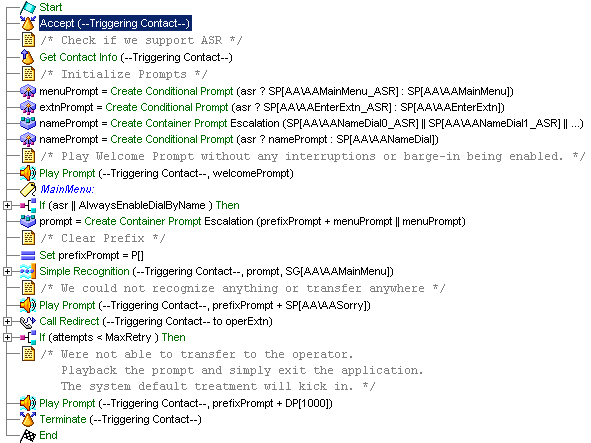The Sample AutoAttendant (aa.aef) Script Template
This simple script template answers a call, asks for the name or extension of the person to whom the caller would like to be connected, and transfers the call.
Note | You can modify the aa.aef file to create your own Cisco Unified IP IVR script. Please make a backup copy of the aa.aef file before modifying it, so that you always have access to the original file. |
The aa.aef script template is a good example of how you can use various steps: steps in the Media palette to receive caller input; the Switch step in the General palette to switch based on a language; steps in the Prompt palette to create a variety of prompts; and steps in the Media palette to specify grammars that recognize caller input.
The aa.aef script template is also a good example of a media-neutral script that accepts either speech or Dual Tone Multi-Frequency (DTMF) input from the caller.
-
Cisco Media Termination (CMT)—Simple media termination, either playing a prompt or receiving DTMF digits
-
Automatic Speech Recognition (ASR)—Speech recognition media
Figure shows the aa.aef script as it appears in the Design pane of the Cisco Unified CCX Editor window.

-
Accepts the call.
-
Plays a welcome prompt, asking the caller to perform one of three actions:
-
Press or say “1” to enter an extension number
-
Press or say “2” to enter the name of a person
If the caller chooses to spell a name, the script maps the letters entered against the available users defined in a specified directory and transfers the call to the primary extension of the user.
If more than one match occurs, the script prompts the caller to choose the correct extension. If too many matches occur, the script prompts the caller to enter more characters. If no match occurs, the script prompts the caller to enter another name.
-
Press or say “0” to speak to an operator
Configure this welcome prompt as a parameter, which means that the administrator can configure this prompt when provisioning an application with this script. (For more information on provisioning applications, see the Cisco Unified Contact Center Express Administration and Operations Guide.)
-
-
When the script receives a valid extension, it transfers the call.
-
If the destination is busy, the caller hears the system prompt, “The phone number you are trying to reach is currently busy.”
-
If the destination is out of service, the caller hears the system prompt, “The phone number you are trying to reach is currently out of service.”
-
The aa.aef script uses audio prompts stored as .wav files in the wfavvid_1001\prompts\system\en_Us\AA\ directory and installed automatically with the Cisco Unified CCX Engine.
-
AAMainMenu_ASR.wav—Provides a menu of choices: press 1 or say “one” to enter an extension, press 2 or say “two” to enter the first few characters of a user name, or press 0 or say “zero” to speak to an operator.
-
AASorry.wav—States that the transfer was not successful.
-
AABusyExtn.wav—States that the dialed extension is busy.
-
AAInvalidExtn.wav—States that the entered extension is not a valid choice.
-
AAExntOutofService.wav—States that the entered extension is no longer in service.
-
AAWelcome.wav—Greets the caller.
In the AutoAttendant application, you configure the filename and pathname for the AAWelcome.wav prompt by running the AA configuration wizard from the main menu of the Cisco Unified CCX Administration web interface. You can choose to change the default welcome prompt to reference a customized prompt.
Note | For custom scripts, you need to record your own prompts. To record a prompt, see the Recording step information in the Cisco Unified Conact Center Express Editor Step Reference Guide or the Cisco Unified Contact Center Express Administration and Operations Guide. |